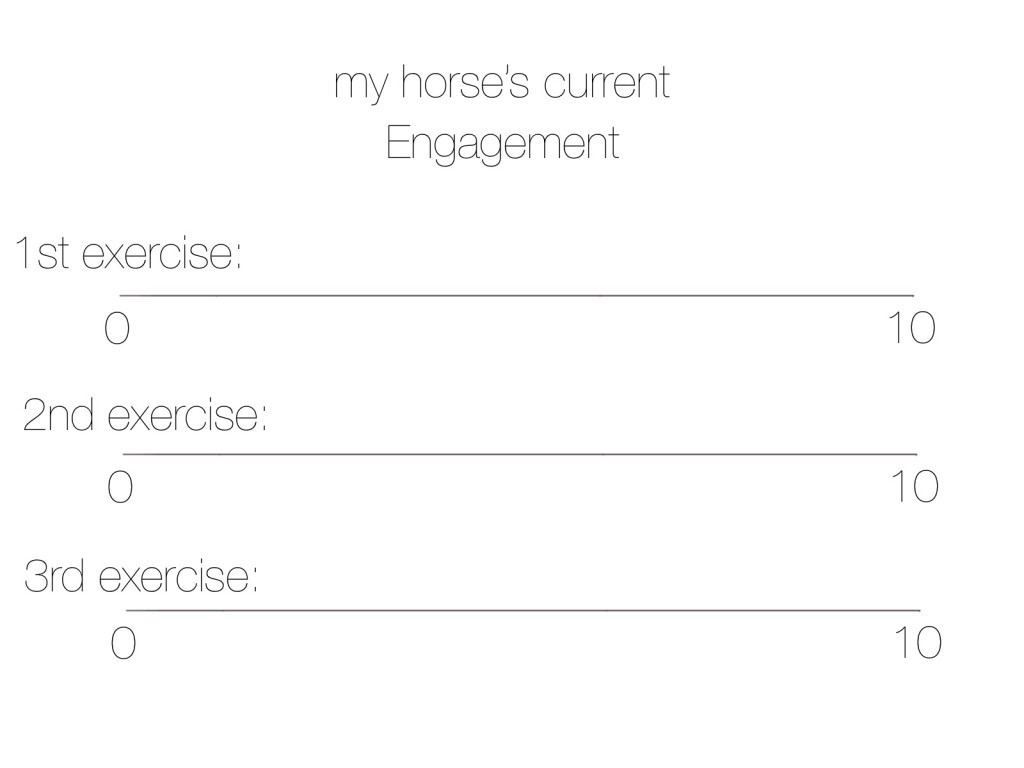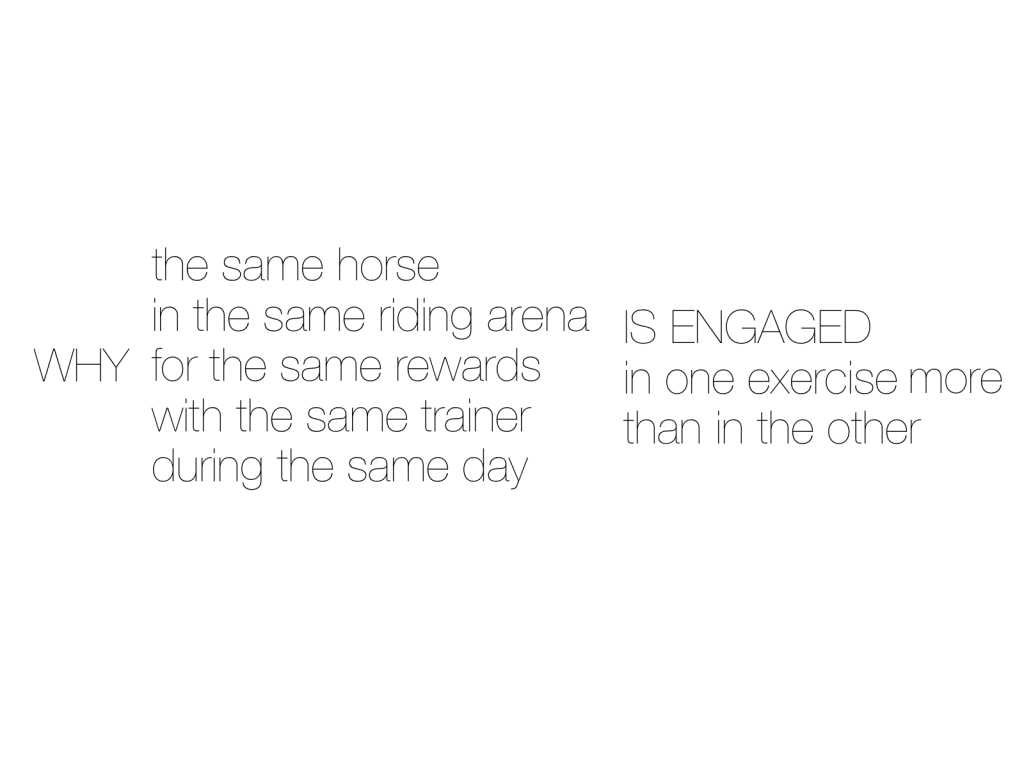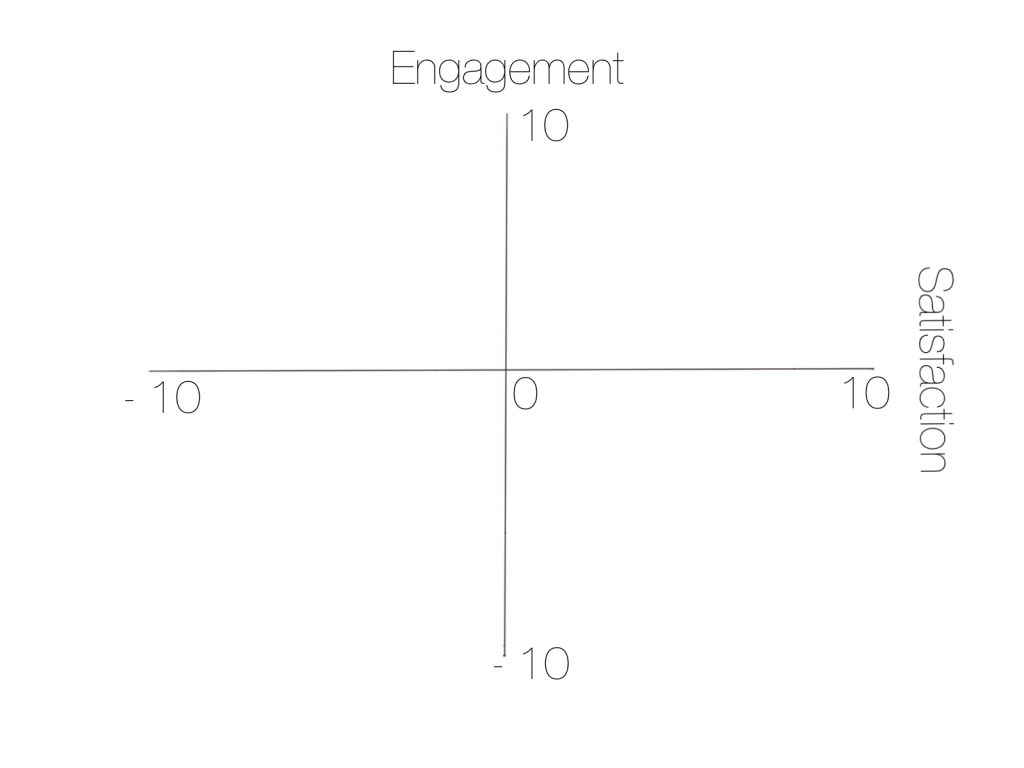I know that our second technique may be something very NEW to you today. Please don’t worry, give yourself time to read it few times and digest it. You will need that time to start understand how to implement it to your everyday trainings.
This is not that hard in practice. To encourage you to try and show you how it looks like in practice I decided to support the theory with few videos showing my horses being engaged and satisfied with their trainings. I will show you here my most advanced horses and the youngsters to show you both: the final stage and the beginnings of this fascinating journey of exploring your horse’s true potential.
During my everyday work with people and their horses I usually see FOUR situations happening:
Horse is engaged and not satisfied.
In my eyes, around 80% of the horses that are clicker trained but their owners didn’t care about the calmness suffers from falling into this group. These horses are pessimistic, they try hard but they don’t see the training goals as theirs. They do not identify with the training and exercises. These horses are clearly not happy with the training. You can see horses that are kicking their owners during “play”, biting, smashing with tails, ears are back all the time, Calming Signals are appearing all the time, horse is hyper-active and finds it hard to calm down, etc. Some of these horses don’t fall into REM Phase of sleep because it’s to stressful for them to lie down in the box and loose other horses from sight. Some of these horses also suffer from pain originating from hooves and back.
Horse is disengaged and unsatisfied.
Unfortunately, many horses that fall into this group are sold after some time because they didn’t have “the right sports soul” for training. These horses are usually called “lazy” and “stupid”. In my eyes 99% of them are in pain originating from hooves and back problems and are given improper training.
Horse is disengaged and satisfied.
These horses are living the dream ;-) Their owners have problems with rising and setting the right criteria, and these horses are not afraid to take the FULL ADVANTAGE of it. Usually these horses are very intelligent and smart and they are training their trainers :-) I have seen many such horses and they were very happy making the criteria lower and lower…and lower… and lower… To my surprise, all of these horses turned into engaged and even more satisfied horses when given the proper training. This is the best proof that all animals need challenges at work and LIKES working situations that stimulate their brains and let them think higher of themselves.
Horse is engaged and satisfied.
During this Workshop we will build-up your horses to be THESE horses :) These horses are not afraid to try and they also don’t want to finish the trainings because they find sessions so enjoyable and fun! They are happy whenever you ask for more and are very willing to give the best out of them each time you ask. If they don’t do something for you, it’s only because it could cause them pain or discomfort. At the same time they are not afraid to tell you this, cause they know that you will understand it and respect it. These horses remain calm throughout the training and are neither unhappy nor stressed when ask for more. These horses make other people drop their jaws because you don’t have to ask for anything during the training – they come with their plan to SHOW OFF and they are not afraid to show you that the sky is the limit for them :)
ENGAGEMENT and SATISFACTION in practice
Now, let’s do some thinking/writing task.
QUESTION 1: Are there situations in your every day life when you see that your horse is very engaged in one exercise and not so much in another one?
QUESTION 2: What are the three most important exercises that you want to master at the moment with your horse? Name them. Measure your horse engagement in each of the three exercises on a scale of 0 to 10. To measure your horse engagement use signs of engagement provided in the material above.
QUESTION 3: Please think for a while about the phenomenon below. Note your answer.
My support: The first Exercise is probably well understood by your horse – your horse knows what you are asking for, he knows the CUE for this exercise and all criteria that are required within this exercise. This exercise is also basing on your horse’s strong sides and abilities and it’s easy for your horse to show off during this exercise, During this exercise your horse has many successes and thus it is building his belief that he is good at it. This exercise is also quite easy yet still interesting for your horse. This exercise is not causing fear or concerns to your horse. Also, there is a huge chance that YOU BEHAVE DIFFERENTLY during the first exercise: probably you feel more calm and secure, you are engaged in this exercise, you find it interesting and enjoyable. And your beliefs about this exercise are that it’s easy and achievable for you and your horse both. And the second exercise is probably lacking all or some of these qualities.
QUESTION 4: Is your horse equally engaged and satisfied in each of the three exercises that are currently most important for your during your everyday trainings?
Try to think where you would place each of the three exercises on this joined scale of Satisfaction and Engagement. For each exercise think about your horse’s engagement and satisfaction level it to know where it should be placed. By doing so you will know which of the golden two – ENGAGEMENT or SATISFACTION – you need to focus now during practicing each of the three exercises you have chosen.
EVERY DAY MOTIVATION
The first question we should ask when entering with our horse the training arena should be always: What does my horse want to do today? What would be most enjoyable for him?
Each time we train our horse we strive for a motivation which is:
- Personal. This means that it is based on what your horse wants to do, not what you want to do,
- Positive. This means that the motivation expresses the appearance of something, by trying your horse can win something and become more aware of his skills and abilities,
- Emotional. This means that the motivation is associated with strong, positive emotions.
- That is based on our horse’s strengths, abilities and goals.
How to increase your horse’s sense of basing on his strengths?
- Bridge your horse’s strengths from one exercise to another,
- Start your sessions with exercises that take advantage of your horse’s strengths,
- Focus on the first step, reward every little trial to make your horse extra sure that what he does is what you ask for. This way you will build up your horse’s courage to take the first step.
How to increase your horse’s a sense of basing on his goals?
- Bridge your horses goals between the exercises. For example: if you see that your horse loves to do Spanish walk invite him to do Spanish trot.
- Find your horse’s goals. Test your rewards – put some carrots, apples, sugar cubes and any other kind of treats in 4 separate bowls and let your horse explore them. See in what order he eats them. Probably he will choose to eat them from the most valuable treat for him to the less valuable.
- Remind your horse that you know his goals and that they are important for you. For example: whenever I practice exercises on the fields and I know my horse is very much interested in eating the grass I frequently take short breaks during which I let my horse eat grass for a while. By doing so I tell my horse: “Look, I know what is important for you, and I will let you realise your goals during breaks. You don’t have to worry about it during the exercises”. I find that this decreases frustration on the horses ten times.
- Show your horse that his actions lead directly to realisation of his goals. Show that exercises are the gateways to your horse’s goals. For example: “If you do this exercise correctly we will enjoy eating the grass for 5 minutes!”.
It does not matter that WE KNOW what strengths our horse has.
It is important that our HORSE KNOWS that WE KNOW what his strengths are.
STRENGTHS and GOALS – are essential in building commitment and satisfaction, and thus – MOTIVATION.
I’d love to show you now how Engagement and Satisfaction look like for two different horses. You will see my advanced mare and my green colt. I hope this will help you put all puzzles together and know what to look for at the beginning and what may be the final effect.
Engagement and Satisfaction: Wiwien, 8yo
Engagement and Satisfaction: Duro, 1yo





